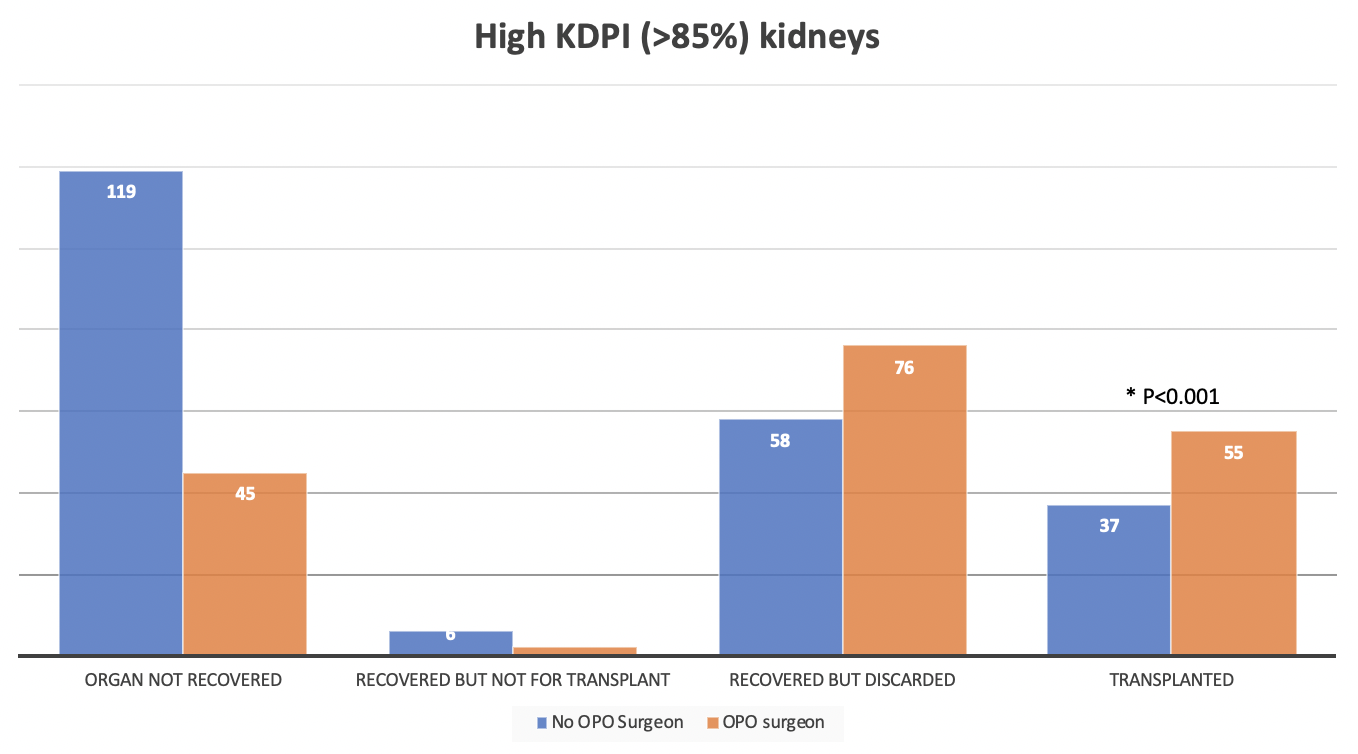Impact of the Organ Procurement Organization Surgeon on Utilization of High KDPI Kidneys
1Surgery, UT Southwestern Medical Center, Dallas, TX, 2Southwest Transplant Alliance, Dallas, TX, 3Medicine, UT Southwestern Medical Center, Dallas, TX
Meeting: 2019 American Transplant Congress
Abstract number: B160
Keywords: Donation, High-risk, Kidney, Resource utilization
Session Information
Session Name: Poster Session B: Kidney Donor Selection / Management Issues
Session Type: Poster Session
Date: Sunday, June 2, 2019
Session Time: 6:00pm-7:00pm
 Presentation Time: 6:00pm-7:00pm
Presentation Time: 6:00pm-7:00pm
Location: Hall C & D
*Purpose: In 2014, TXSB organ procurement organization (OPO) employed a full-time donor surgeon. We previously demonstrated that presence of a donor surgeon had a beneficial effect in marginal liver placement. We questioned if the presence of an OPO surgeon affects utilization of high kidney donor profile index (KDPI) kidneys and examined if a similar effect occurs with kidney placement.
*Methods: OPO data was obtained for all procurements that were performed over a 7-year time period between 2010-2017. The OPO surgeon started performing procurements in April 2014. All donor procurements were included for analysis, and a high KDPI donor was defined as a KDPI of >85%. Analysis was performed to see if presence of a donor surgeon affected the use of high KDPI kidneys. Donor and recipient demographic data were examined. A p-value of <0.05 was considered to be significant.
*Results: There were 430 procurements with donors with a KDPI of >85%. Of those, 94 (21.9%) had an OPO surgeon involved, while 336 did not. There were no significant differences between the two groups in terms of donor demographic data, including age (57.1 vs. 59.8 years), KDPI (94% vs. 93%), donor creatinine (2.48 vs. 2.20 mg/dL), or cold storage time (21.8 vs. 23.7 hours) for donors with and without OPO surgeons, respectively. Kidneys with an OPO surgeon were transported greater distances (248.3 vs. 183.4 miles, p < 0.05), and donation after cardiac death (DCD) donors in this high KDPI group were only performed with the presence of a donor surgeon (N = 4 donors). Reasons for discard have changed from discard for donor biopsy (33.3%) and list exhausted (33.3%) to list exhausted (70.3%) with the presence of a donor surgeon (p < 0.05). In the presence of an OPO surgeon high KDPI kidneys were much more likely to be recovered for possible transplant (74% v43%), increasing the discard after procurement (43% v 27%). Most importantly, the OPO surgeon increases percentage of high KDPI kidneys used for transplant (16% v 29%, p<0.001). When examining kidneys that were transplanted, the dispositions of the kidneys have increased from 26.8% to 30.9%, p < 0.05.
*Conclusions: The presence of an OPO surgeon has increased utilization of high KDPI kidneys. DCD high KDPI kidney donors only had an OPO surgeon involved with procurement. Presence of an OPO surgeon has allowed the OPO to pursue more marginal donors that otherwise may not have been recovered without a designated surgeon.
To cite this abstract in AMA style:
Hwang CS, Reese J, Anthony T, Vagefi P, Tanriover B, Ariyamuthu V, Levea S, MacConmara M. Impact of the Organ Procurement Organization Surgeon on Utilization of High KDPI Kidneys [abstract]. Am J Transplant. 2019; 19 (suppl 3). https://atcmeetingabstracts.com/abstract/impact-of-the-organ-procurement-organization-surgeon-on-utilization-of-high-kdpi-kidneys/. Accessed December 24, 2025.« Back to 2019 American Transplant Congress

